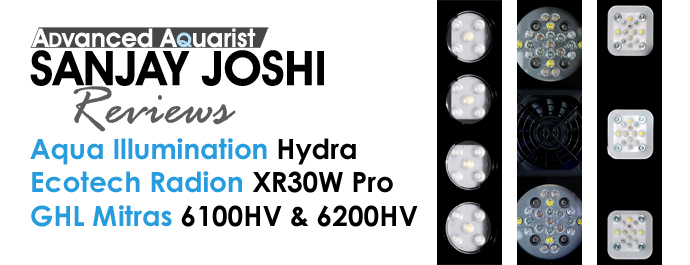
The promise of LED technology to be able to offer an infinite range of color and controllability is finally reaching the point of reality. LEDs have to potential of offer unparalled controllability allowing users to control a wide range of features such as – spectrums, color temperatures, ability to vary these throughout the day, add special effects such as cloud covers and lightning, tight integration with modern aquarium controllers, wi-fi and internet based control. Additionally, the ability to upgrade using single platforms can provide users with a path to address rapid obsolescence as well as the ability to tweak the fixtures to the application. The new “high end” LED fixtures such as the Ecotech radion Pro, GHL Mitras, and AI Hydra are perfect examples of these capabilities.
Continuing in the same vein as my previous LED lighting tests, this article presents data on light intensity and spread along with spectral plots for these new LED fixtures. Table 1 presents a list of the LED lighting fixtures reviewed in this article. Each of these was tested using the same set up as my previous reflector tests, using a 3’X3′ grid with a spacing of 3″ in the X,Y direction. The fixtures were centered on this grid, and PAR was measured as PPFD (Photosynthetic Photon Flux Density) in micromoles/m2/sec using a LICOR 1000 data logger and a LI-192SA underwater cosine corrected sensor calibrated for both air and water. The data logger was set to average 5 readings for each data collection point. The data was imported into Microsoft Excel for analysis and the data was plotted to display the light spread and intensity at various distances. 4 plots of the data with 2 plots at each distance were generated showing:
- A 3-D surface plot showing the actual PAR values recorded
- A contour plot viewing the surface from the top showing the distribution
The spectral distributions were measured using the Licor LI-1800 spectroradiometer. The spectral data was collected from the various LEDs and normalized such that integrated light output (spectral irradiance) between the wavelengths of 400-700 nm was 100 Watts/m2. Data was collected at full power output for the individual channels of light control (e.g., Blue, white) along with data with ALL LEDs on at full power. The data was normalized so that the total irradiance was at 100 Watts/m2 over the wavelength range 400-700 nm. The various LED color outputs were then scaled by the same scale factor to allow of determination of the contribution of the various LEDs to the full output. The results are plotted as a Spectral power distribution plot. The fixtures were tested for light spread and intensity at 24″and 30″, unless otherwise noted. Power draw was measured with a Kill-A-Watt meter.
| LED Fixture | Picture |
|---|---|
| Ecotech Marine
radion Pro |
|
| GHL
Mitras 6100 |
|
| GHL
Mitras 6200 |
|
| Aqua Illumination
Hydra |
| LED Fixture | Ecotech Marine radion Pro | AI Hydra | GHL MItras 6100HV | GHL Mitras 6200HV |
|---|---|---|---|---|
| # of LEDs | 42 | 20 | 72 | 72 |
| Type and LED groups | White: 8 Cree XT-E Cool White (5w each)
Red: 4 Osram Oslon SSL Hyper Red, 660nm (3w each) Yellow: 2 Osram Oslon SSL Yellow, 590nm (3w each) Green: 4 Cree XP-E Green, 520nm (3w each) Blue: 8 Cree XP-E Blue, 468nm (3w each) Royal Blue: 8 Cree XT-E Royal Blue, 442nm (5w each) Indigo: 4 SemiLEDs UV, 415nm (2.5w each) Ultraviolet: 4 SemiLEDs UV, 405nm (2.5w each) |
White: 4 Cree XT-E Cool White
Red: 2 Osram Oslon Deep Red Green: 2 Cree XP-E Royal Blue: 4 Cree XT-E Blue: 4 Osram Olson Very Deep Blue Violet: SemiLED 415nm Violet UV: Edison Opto 400 nm UV |
White: 12 Cree XT-E cool white
Neutral White: 6 Cree XT-E neutral white Red: 6 Osram Oslon SSL red Hyper Red: 6 Osram Oslon SSL hyperred Blue: 12 x Cree XP-E blue Royal Blue: 12 x Cree XT-E royal blue Green: 6 x Osram Oslon SSL true green Yellow: 6 x Osram Oslon SSL yellow Hyper Violet: 6 425 nm |
White: 12 x Cree XT-E cool white
Blue: 12 x Cree XP-E blue Royal Blue: 12 x Cree XT-E Neutral White: 6 x Cree XT-E Green: 6 x Osram Oslon SSL true green Sky White: 6 x Osram Oslon SSL Blue White: 6 x Osram Oslon SSL Red: 6 x Osram Oslon SSL hyperred Hyper Violet: 6 x hyper violet 425 nm |
| # of control Channels | 6 | 7 | 9 | 9 |
| # of LED groups/type | 8 | 7 | 9 | 9 |
| Peak Spectral Range of LEDs | 405 nm – 660 nm | 400nm-660nm | 425-660 nm | 425-660 nm |
| Wireless Control | communicates wirelessly with other radion lights and VorTech pumps through EcoSMART Live | Wireless remote control | communicates wirelessly with other Mitras lights and ProfiLux Controllers (with expansion card “PLM-PWC”) or PC (with USB-wireless dongle)* | communicates wirelessly with other Mitras lights and ProfiLux Controllers (with expansion card “PLM-PWC”) or PC (with USB-wireless dongle)* |
| Control Software | Cloud based -EcoSMART Live | Web based Director, MyAI cloud based | PC based operating software | PC based operating software |
| Tethering Required for Control | Yes – USB | No | Yes – USB | Yes – USB |
| Control Features
Sunrise Sunset |
Over Multiple lamps | Over Multiple lamps | Over Multiple lamps | |
| Cloud Simulation | Yes | Sweeping over multiple lamps | Sweeping over multiple Lamps | Sweeping over multiple Lamps |
| Thunder Storm | Yes | Yes | Yes | Yes |
| Moon Phases | Yes | Yes | Yes | Yes |
| Rainy Days | Yes | Yes | Yes | Yes |
| Upgradability | Lens LED clusters Driver |
Led Clusters Lens |
Replaceable LED clusters | Replaceable LED clusters |
| Cooling | Air cooled with one water resistant cooling fan | Air Cooled with one cooling fan | 4 cooling fans | 4 cooling fans |
| Other Noteworthy features | Capacitive touch exterior controls | Remote with touch controls | Exterior Touch LED control panel | Exterior LED touch Panel |
| Lenses | Custom TIR Lenses | Custom TIR lenses (80 deg), also available with 50 deg. | Metal coated PET reflector, 99% total reflection 96% diffuse | Metal coated PET reflector, 99% total reflection 96% diffuse |
| Size | L: 11.8 in. W: 7 in. H: 1.5 in |
L: 11.875 in. W: 5.375 in. H: 2.1 in. |
L: 13.38 in W: 7.08 in H: 1.57 in. |
L: 13.38 in W: 7.08 in H: 1.57 in. |
| Weight | 3.66lbs. (1.66kg) | |||
| Power Consumption at Full Power | 170W | 95 W | 190W (high output) 120W (high efficiency) |
190W (high output)
120W (high efficiency) |
| Regulatory Compliance | . | UL, CE & RoHS | . | . |
* Not available in the current version tested
Ecotech Marine radion Pro
The radion Pro is the latest generation of the Ecotech Radion LED series. The relevant information regarding the various LEDs and other features is summarized in Table 2. The basic Led arrangement is shown in figure 1. Figures 2 and 3 show the light distribution and the spectral outputs of the various LEDs.
Aqua Illumination Hydra
The AI Hydra is the newest of the Aqua Illumination (AI) product based on the same AI Vega platform. It offers less flexibility than the AI Vega in terms of control however it still provides 7 channels of control which is more than adequate to create a wide range of colors. The LED pucks are not upgradable as they are in the AI Vega. The relevant information regarding the various LEDs and other features is summarized in Table 2. The basic Led arrangement is shown in figure 4. Figures 5 and 6 show the light distribution and the spectral outputs of the various LEDs and control channels.
GHL Mitras 6100HV and 6200HV
The GHL Mitras are LED pendant lights from Germany. The Mitras LX platform is the basis for a wide range of LED configurations. Two of them the 6100HV and the newer 6200HV are tested here. The relevant information regarding the various LEDs and other features is summarized in Table 2. The only major difference between the 6100HV and 6200HV is in the configuration of the LEDs. All other features are identical. The 6200HV has more blue and less red whereas the 6100HV is designed to provide a fuller spectrum. Both the 6100HV and 6200HV were tested for spectral output, but only the 6200HV was tested for light distribution.
The basic Led arrangement is shown in figure 7. Figures 8 and 9 show the light distribution and the spectral outputs of the various LEDs for the GHL Mitras 6200HV and Figure 10 shows the spectral output for the GHL Mitras 6100HV.
Discussion
The latest generation of LEDs with their range of multicolor LEDs and multiple channels of control offer unprecedented ability to create a wide range of colors that would suit the aesthetics of the aquarium couple with the requirements of the coral. All of these LEDs are typically programmed through software interface that allows great amount of flexibility in configuring the colors, the ability to ramp the intensity up and down to create effects such as sunrise, sunset, moving cloud covers, lightning simulation, moonlight simulation, and for some even different power settings for high output and high efficiency.
To facilitate ease of programming the colors, often the software includes preprogrammed color temperatures. This range of color temperatures is obtained by dimming some of the LEDs, which in turn leads to lower output as well as lower power consumption. For example, Figure 11, shows the various spectrums of the preprogrammed color temperatures of the GHL Mitras 6200HV. Table 3 shows the power consumption at the different preprogrammed color temperatures.
| Programmed Color Temp.6200HV | Power(Watts) |
|---|---|
| 2000K | 32 |
| 4000K | 62 |
| 6010K | 85 |
| 8000K | 120 |
| 10010K | 190 |
| 12000K | 155 |
| 14000K | 120 |
| 15940K | 120 |
| 17700K | 92 |
| ALL ON | 208 |
The GHL Mitras also allow the user to pick between 2 operating modes – High output and High efficiency. The difference in the output at these 2 modes is shown in table 4, and Figure 12.
| LED | Mode | Power | PPFD at 12.5″ |
|---|---|---|---|
| GHL 6200 HV | High Output | 208W | 781 |
| High Efficiency | 135W | 554 | |
| GHL 6100 HV | High Output | 181W | 645 |
| High Efficiency | 118W | 475 |
Figure 12: Change in Spectral Output of GHL 6200 HV and 6100HV in High Output and High Efficiency modes.
While all of the LED manufacturers provide the power consumption data for the LEDs, the actual power draw as measured by a Kill-A-Watt meter is shown in Table 5. Figure 13, shows the spectral comparison between the different LEDs at maximum output normalized to a spectral irradiance of 100W/m2. Since all of them tend to use the same manufacturer of LEDs, the only major differences are from the composition of the LEDs used.
| LED | Power (Watts) | Amps (A) | Volts (V) | Power Factor (PF) |
|---|---|---|---|---|
| AI Hydra | 95W | .77 | 122.5 | .99 |
| Radion Pro | 171W | 2.65 | 123.3 | .54 |
| GHL 6200 HV (high output) | 208W | 1.73 | 122.1 | .99 |
| GHL 6200 HV (high efficiency) | 135 | 1.11 | 122.4 | .99 |
| GHL 6100 HV (high output) | 181 | 1.5 | 121 | .99 |
| GHL 600 HV (high efficiency) | 118 | .9 | 122.9 | .99 |
Comparing the light distribution of these LEDs as shown in Figures 2, 5 and 8 are useful to provide insight into the practical use of these LEDs. At first glance it may seem like AI Hydra does not have the spread or intensity as compared to the other 2. But this is very misleading without considering the power consumption. Since all of these different LED fixtures use almost identical LEDs from Cree and Osram, the main differences in output are directly related to power consumption and numbers of individual and different LEDs and optics. The AI Hydra for example uses only 95W of power as compared to a radion at 171W and GHL 6200HV at 208W. So, in practice you may have to use 2 AI Hydra to get the equivalent light output of the other two. At around ½ the price of a radion Pro, using 2 AI Hydra may be better option for your application. Remember that the light intensity is additive where it overlaps. Running the lights at full output shows that the GHL Mitras has the largest distribution of light and would be suitable for the coverage of about a 3 ft square area, and hence suitable for larger tanks. The radion Pro on the other hand, has a slightly smaller distribution than the GHL, but achieves higher intensity at the same distances. This makes it more suitable for taller tanks, or they can be mounted higher to get a larger spread.
Conclusion
LED lighting has come a long way and the new generation of LED fixtures is delivering on the promise of LED technology, and control features. As usual, the users need to consider their own applications to determine the best one for the situation. Hopefully this data will be helpful in making your decisions.


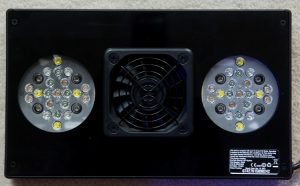
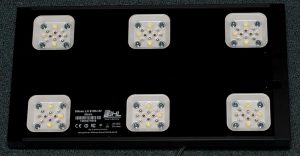


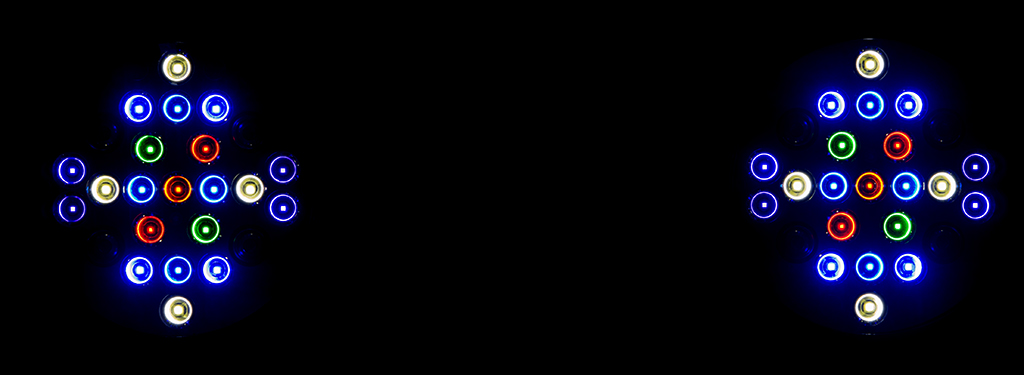


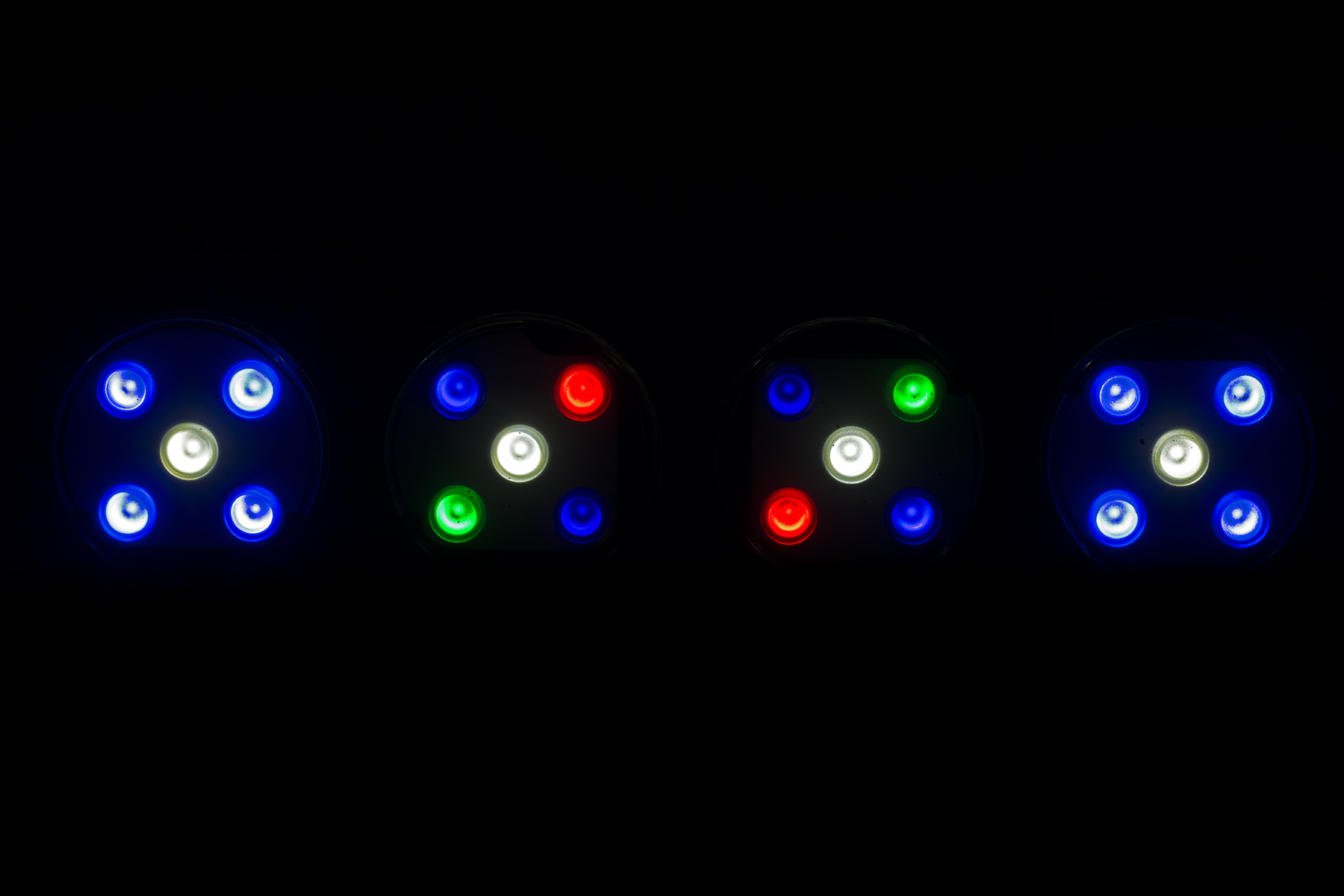
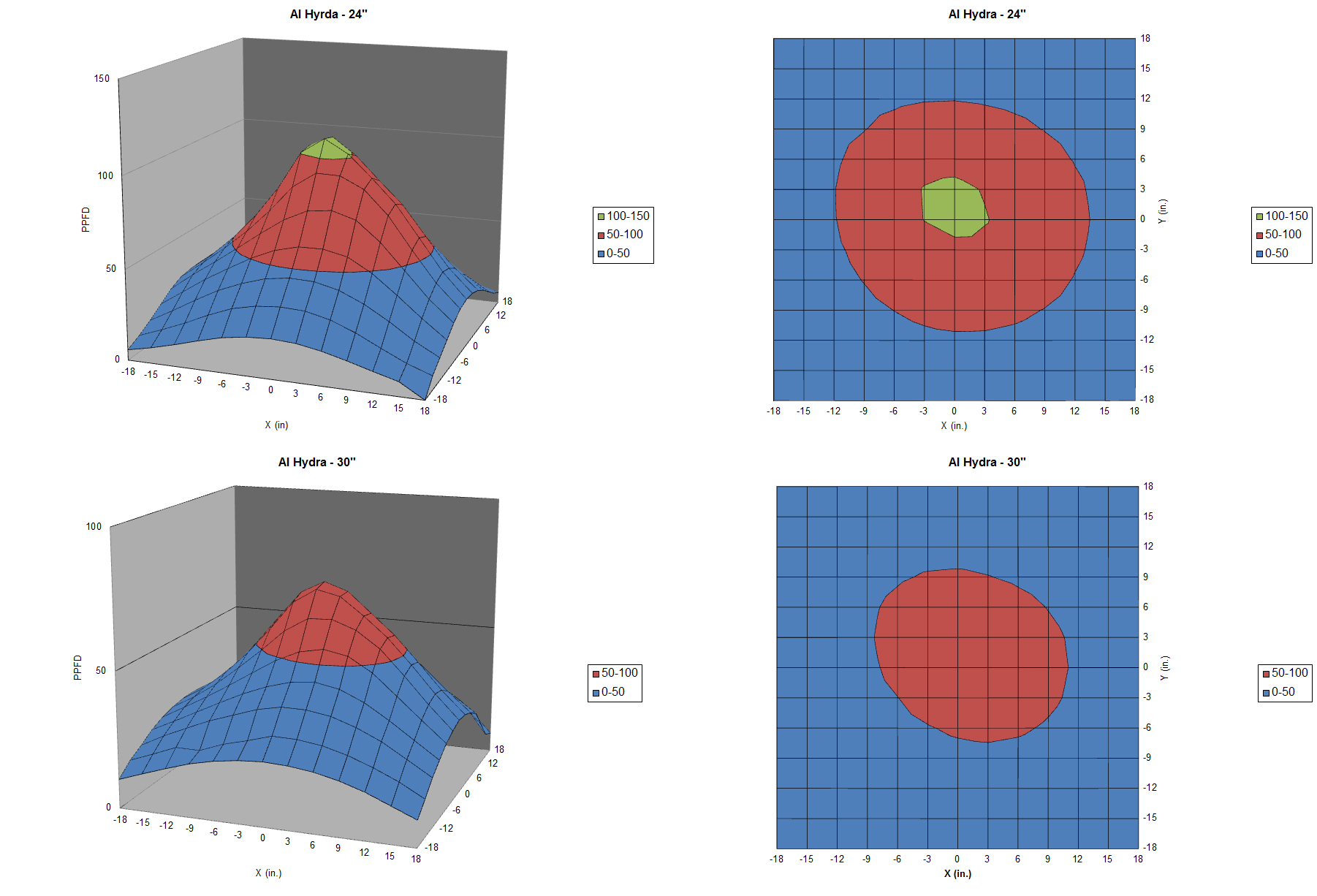
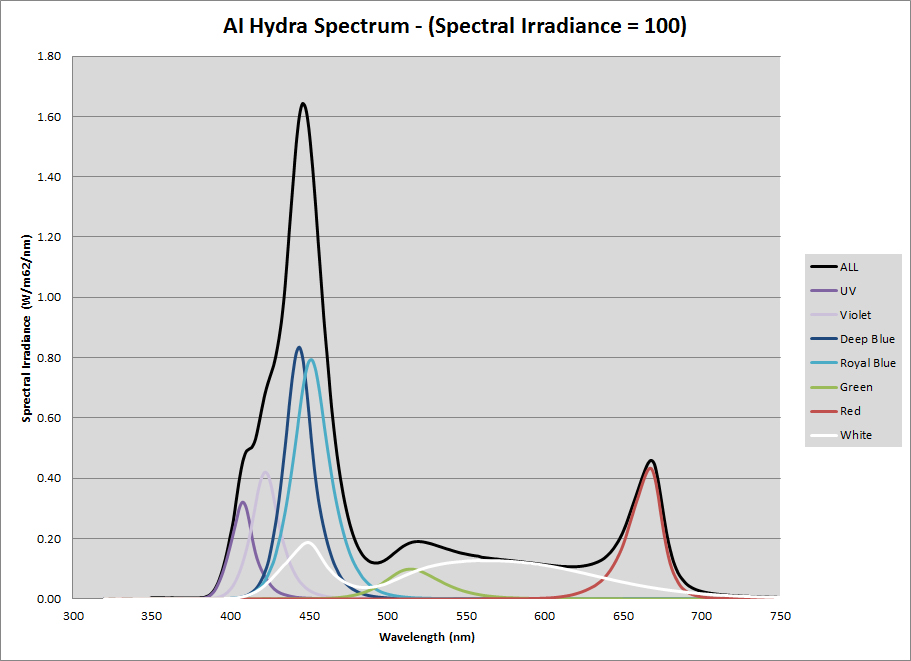

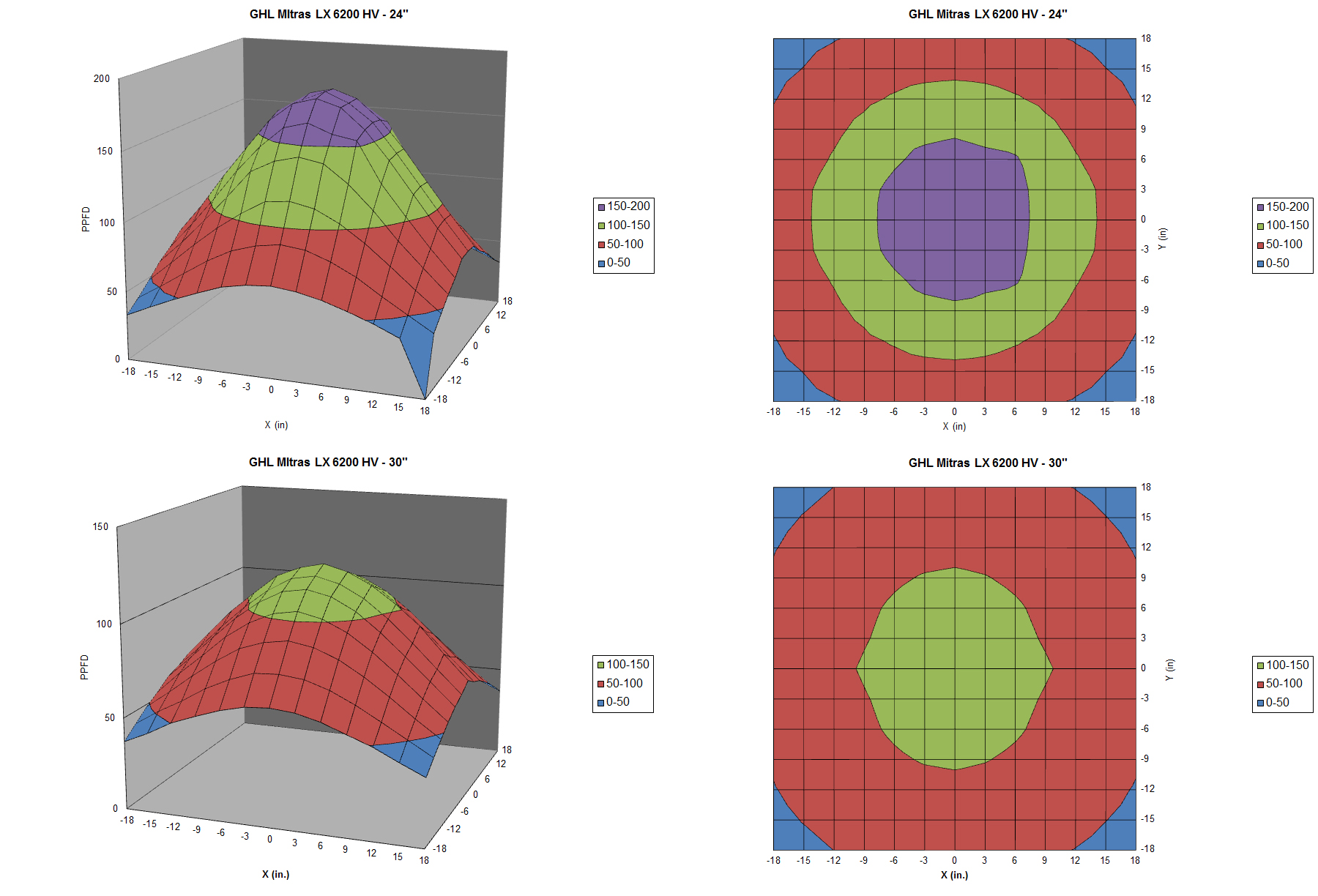
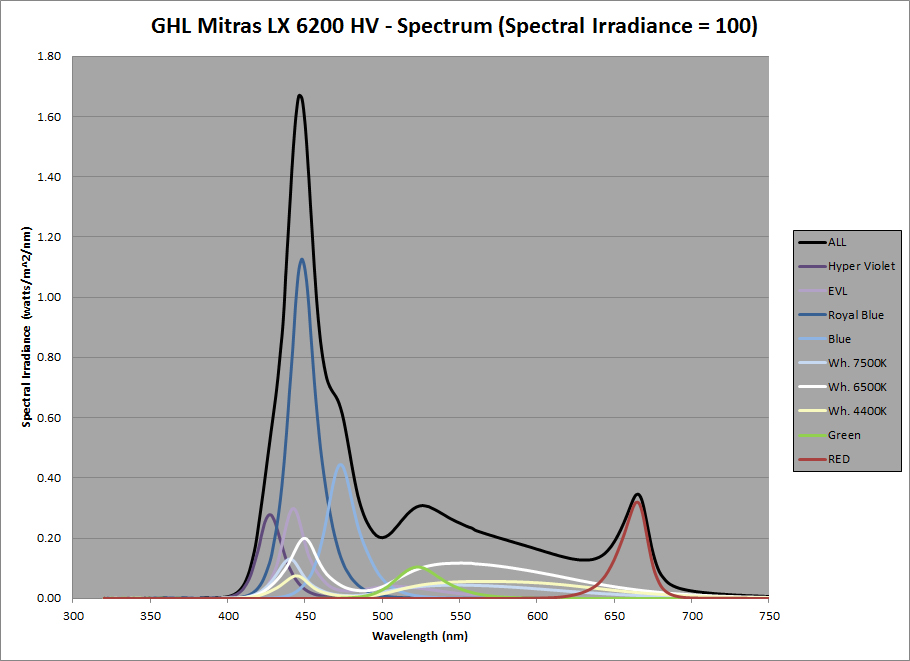
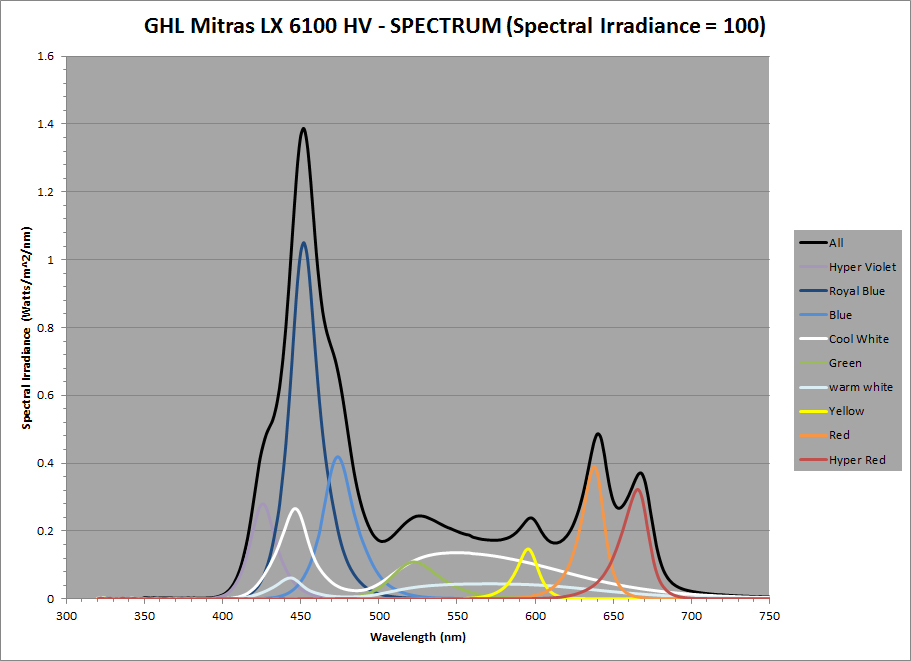
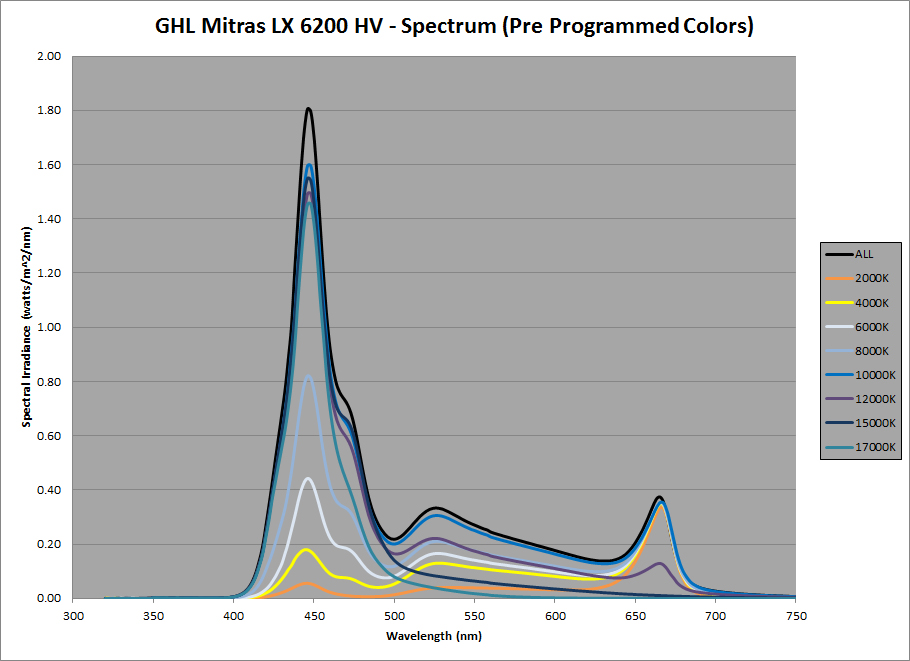

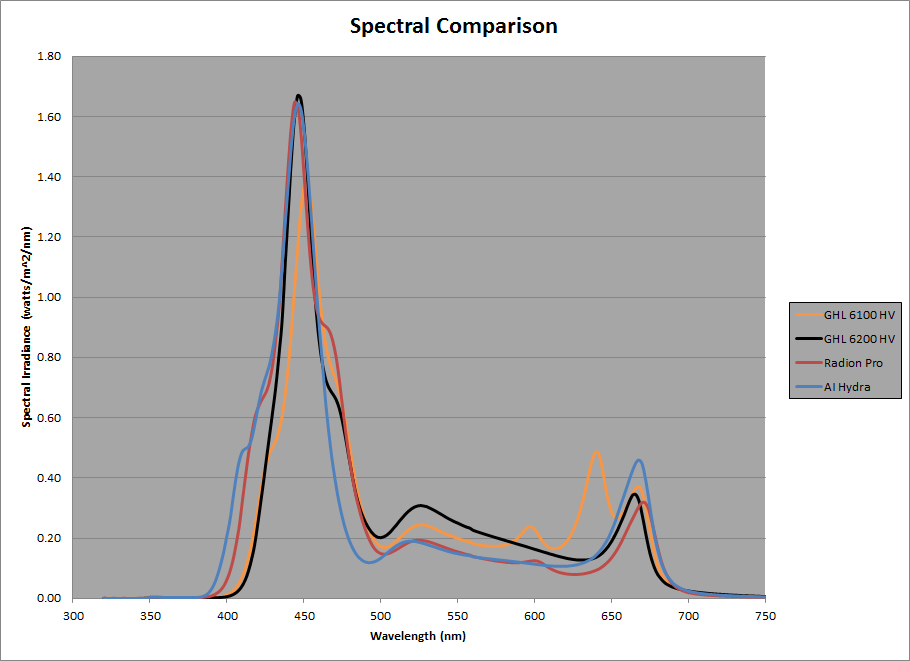

0 Comments